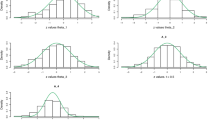Abstract
In the present paper, we study the analytical properties of an addictive hazards model. The ageing properties of the baseline random variable and the induced random variable are compared. Various stochastic orders that relate these two variables are also explored.
Similar content being viewed by others
References
Badia FG, Berrade MD, Campos CA (2002) Ageing properties of the additive and proportional hazards mixing model. Reliab Eng Syst Saf 78: 165–172
Bartoszewicz J, Skolimowska M (2006) Preservation of stochastic orders under mixtures of exponential distributions. Probab Eng Inform Sci 20: 655–666
Chen YQ, Rhode CA, Wang MC (2002) Additive hazard models with latent treatment effectiveness. Biometrika 89: 417–931
Davis HT, Feldstein M (1979) The generalised pareto law as a model for progressively censord data. Biometrika 66: 299–306
Hjorth U (1980) A reliability distribution with increasing, decreasing, constant and bathtub shaped failure rates. Technometrics 22: 99–107
Jiang R, Ji P, Xiao X (2003) Ageing property of univariate failure rate models. Reliab Eng Syst Saf 79: 113–116
Lai CD, Xie M (2006) Stochastic ageing and dependence for reliability. Springer, New York
Lim HJ, Zhang X (2009) Semiparametric additive risk models: application to injury duration study. Accid Anal Prev 41: 211–216
Marshall AW, Olkin I (2007) Life distributions. Springer, New York
Murthy VK, Swartz G, Yuen K (1973) Realistic models for mortality rates and estimation, I and II, in technical reports. University of California, Los Angeles
Nanda AK, Bhattacharjee S, Alam SS (2007) Properties of ageing intensity functions. Stat Probab Lett 77: 365–373
Shaked M (1977) Statistical inference for a class of life distributions. Commun Stat A 6: 1323–1329
Shaked M, Shanthikumar JG (2007) Stochastic orders. Springer, New York
Sun L, Park D, Wang MC (2006) The additive hazard model for recurrent gaps times. Stat Sinica 16: 919–932
Author information
Authors and Affiliations
Corresponding author
Rights and permissions
About this article
Cite this article
Nair, N.U., Sankaran, P.G. Some results on an additive hazards model. Metrika 75, 389–402 (2012). https://doi.org/10.1007/s00184-010-0332-6
Received:
Published:
Issue Date:
DOI: https://doi.org/10.1007/s00184-010-0332-6




